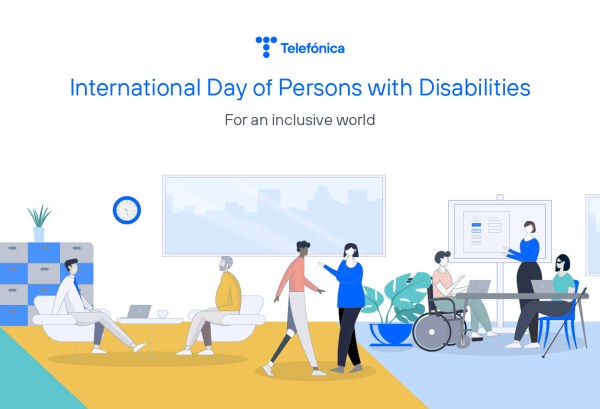The evolution of the rights of people with disabilities has gone from being an issue of little relevance, or even with a treatment that today could be pejorative -such as the United Nations Decade for the Disabled, between 1983 and 1992-, to being a priority issue.
An example of how society has been evolving in these matters is the GAAD principles of the GSMA, an association that includes more than a thousand mobile operators and companies in the ecosystem.
GSMA’s ‘Principles for Advancing Digital Inclusion of People with Disabilities’.
Recently, Telefónica reaffirmed its adherence to the ‘Principles for Advancing the Digital Inclusion of People with Disabilities’ (known as GAAD) promoted by the GSMA, which it had already joined in 2020.
In this way, the operator increased its commitment to accessible solutions as an element of its strategy and whose objective is to accelerate responsible digitalization that generates both competitiveness and positive impact for all people, leaving no one behind.
As Eduardo Navarro, Telefónica’s Global Director of Corporate Affairs and Sustainability, summarized in the press release on this issue, “accessibility and disability inclusion are not only ethical imperatives, but also strategic business priorities for the company. Improving accessibility for people with disabilities allows us to attract, retain and maximize the potential of this talent”.
An issue he quantified in that “by providing a barrier-free experience for our customers, we have the opportunity to better serve the 15% of the population that experiences significant disabilities.”
A group of people with disabilities, whose rights have been advancing in recent decades as we will see throughout the article.
In the 2024 edition, Telefónica is advocating for Talent without labels, recalling the ‘transformative potential of new technologies to improve people’s lives and incorporate accessibility into all our products, services, facilities and channels.’
Convention on the Rights of Persons with Disabilities
Adopted by the United Nations General Assembly – one of the main UN bodies – in 2006 and in force since 2008, the Convention on the Rights of Persons with Disabilities is an international human rights instrument that aims to protect the rights and dignity of persons with disabilities.
A convention that follows the International Day of Persons with Disabilities, which every December 3 since 1992 also seeks to “promote the rights and welfare of persons with disabilities in all areas of society and development, as well as to raise awareness of their situation in all aspects of political, social, economic and cultural life”.
General principles of the Convention
But to return to the Convention, it is based on eight general principles, set out in Article 3 as follows:
- Respect for inherent dignity, individual autonomy, including the freedom to make one’s own decisions, and personal independence.
- Non-discrimination.
- Full and effective participation and inclusion in society.
- Respect for difference and acceptance of people with disabilities as part of the human diversity and condition.
- Equal opportunity.
- Accessibility.
- Equality between men and women.
- Respect for the evolving capacities of children with disabilities and their right to preserve their identity.
What the Convention seeks
The first article of this document promoted by the UN specifies that persons with disabilities refers to those who “have long-term physical, mental, intellectual or sensory impairments which, in interaction with various barriers, may hinder their full and effective participation in society on an equal basis with others”.
This same Article 1 specifies that the purpose of this text is “to promote, protect and ensure the full and equal enjoyment of all human rights and fundamental freedoms by all persons with disabilities, and to promote respect for their inherent dignity”.







